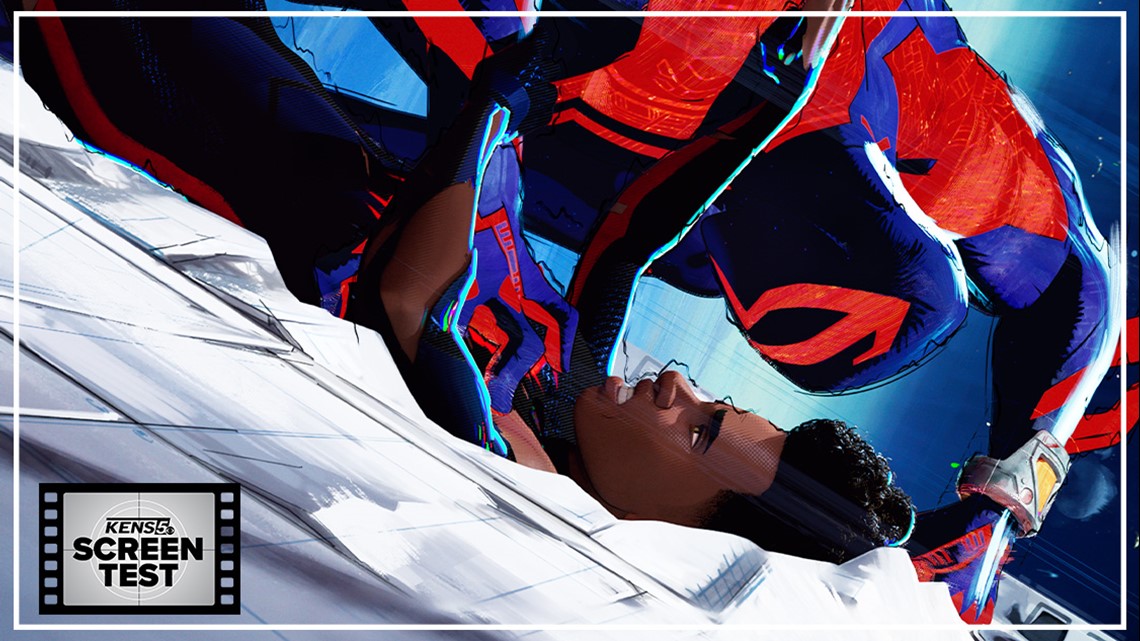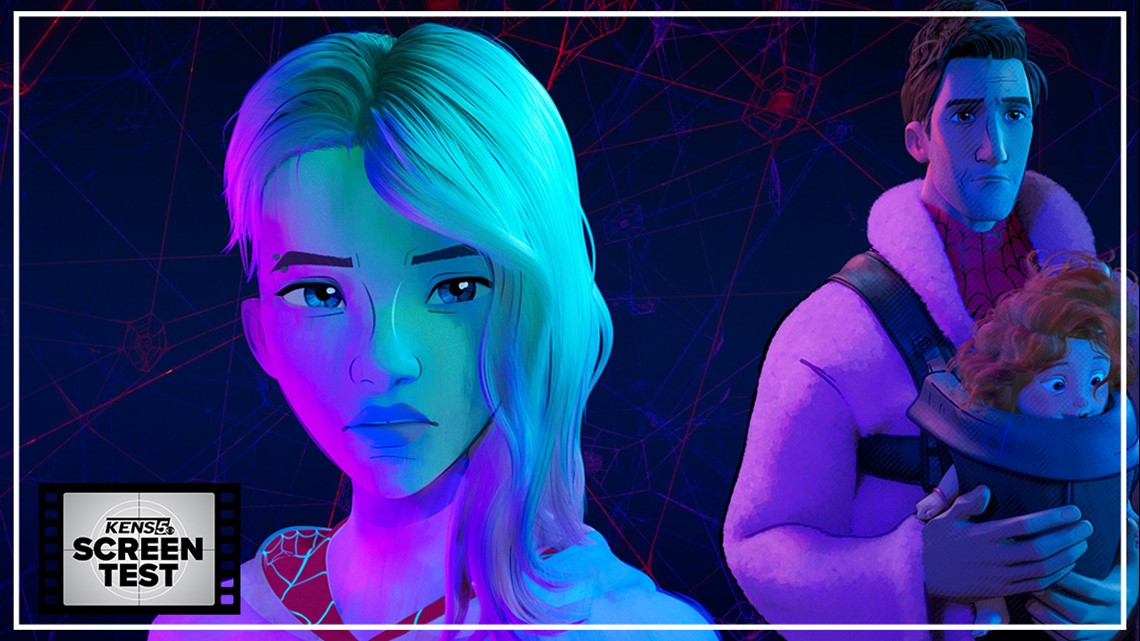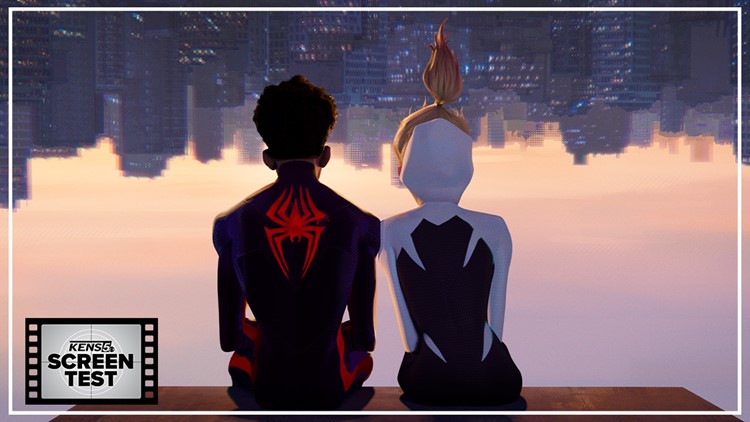TEXAS, USA — For a movie about a superhuman’s extremely human struggle to be in the right place at the right time for the people who matter most, there’s something uncannily heroic about the timing of “Spider-Man: Across the Spider-Verse," opening in theaters Friday.
It was just in the last few weeks that Vin Diesel and his “Fast and Furious” troupe weightlessly crashed vehicles together en route to a frustrating excuse for a cliffhanger that left us feeling neither like our nerves were on a cliff’s edge nor that we wouldn’t already know how soft the landing will be. “Across the Spider-Verse,” a magnificent and long-awaited sequel to 2018’s cinematic disruptor, also saves much of its resolution for a third Miles Morales movie (the bifurcation was announced in 2021) but fully earns its ellipsis. It isn’t because it's so narratively busy you talk yourself into believing a 140-minute investment was worth it that “Spider-Verse” is both the best animated movie and best comic book film to emerge from Hollywood in recent years; it’s the creators’ savvy at weaving a web so intricate and delicate that you can’t help but want to see the full design for yourself. The film is durable enough to catch whatever sequelitis-induced headache you might've sustained from "Fast X" and remedy it too.
I don’t mean to rain on Dominic Toretto’s parade in order to sing “Across the Spider-Verse’s” praises, but it’s difficult not to when the latter makes a literal antagonist out of rigid devotions to formula. That would be Miguel O’Hara, one drop in a sea of Spider-People and a complicated zealot figure dedicated to upholding a single sacred way that things must be. Another impeccable bit of timing on the movie’s part comes when explicit — and undeniably intentional — reference is made to algorithms, a bold moment that stunned me the strongest in a movie with high-wattage cameos and jaw-dropping visual invention. Not for nothing does the worshipful heralding of a Manifest-Destiny-like “Canon” ring as commentary in the age of meticulous franchise blueprinting, when the only emotions that apparently matter are anticipation.
Juxtapose that with the necessarily cluttered tangle of Miles’ various personal commitments – and the youthful verve that voice actor Shameik Moore gives to them – and it’s hard not to think the journey of fate and carving an original path he embarks on here arrives at a critical juncture for cinematic storytelling. Pretty good for the sequel to a movie that made Spider-Ham a household name.
If this all makes it sound like “Across the Spider-Verse” – directed by Joaquim Dos Santos, Justin K. Thompson and, most tellingly, “One Night in Miami…” screenwriter Kemp Powers – puts meticulous calculation of conviction over characters, rest assured that’s part of its genius. Pay close attention, when the number of Spider-Denizens filling the screen starts bordering on the ludicrous, to which central variations of the hero have made a life for themselves outside the spider-suit and which have dedicated themselves to living, breathing and sleeping that mantra of great responsibility.
Regardless, Miguel doesn’t fully enter the fray until the movie’s second hour. But “Across the Spider-Verse” needs just a few moments to make good on its title’s promise, opening at the other end of the multiverse to catch us up with returning Spider-Woman Gwen Stacy (Hailee Steinfeld) and her own anxieties—chief among them her police-captain father hunting down their universe’s webslinger that he doesn’t know is living under their roof. (Great power can be such a drag, huh?) In an early sign that “Across the Spider-Verse” has at least met the high bar set by its predecessor, this extended cold open plays out with a rollicking sense of momentum and consequence, punctuated with Gwen battling a 16th-century Vulture who’s glitched into her universe. He’s animated to resemble the scraggly drawings of his era’s da Vinci, his sharp-lined features contrasting a gorgeous watercolor aesthetic whose hues brighten, darken and run in lockstep with Gwen’s problems. By the time she leaves to join Miguel’s Spider-Society after a key moment of reckoning, the colors of that aesthetic have virtually bled over any recognizable inch of her New York City.
In Miles’ universe, problems are mounting, among them missed classes, frustrated parents and bouts of loneliness. Nibbling closer to the bottom of the list is a freakish new foe called The Spot, whose unfortunate proximity to the last movie’s events rendered him a permanent and unpredictable multiversal bypass on two legs. You never know how he'll splice the physical realm, and the idea is taken to deliriously fun lengths. He’s a horrifically tragic ne'er do well who Miles momentarily dispatches with ease, a funny and psychedelic set piece that serves as an ecstatic reminder that the “Spider-Verse” animators approach every sequence with a mission to one-up themselves.


You find yourself levitating in your seat off the filmmakers' enthusiasm, showcased with minute-to-minute consistency. It’s in the way “Across the Spider-Verse” flirts briefly and thrillingly with live-action, and other mediums of a more brick-tastic persuasion. You see it in how characters are textured to reflect their roles in any given scene. You sense it in the sheer entertainment value of lightning-fast storytelling that knows precisely when to slow things down, and for how long. You feel it when Gwen finally revisits Miles’ universe as things tip into lovingly crafted teen-romance mode as gracefully as the two Spider-Kids strutting over and under a sky-high perch. Even as it comes ever so close to surrendering its idiosyncratic charm when iconic past “Spider-Man” stories are looped in at an awkward moment, you understand it’s in service of a powerful ethos: Lack of shared experience shouldn’t be cause for exclusion.
Those heady ideas come like a carefully placed strand of web giving new velocity to the film’s early sequences, which focus largely on Miles’ fraught relationship with his parents and the community he identifies with versus the community he protects. If the multiplicity of his concerns has you anxiously glancing your watch to see when he’ll go multiverse-jumping, here’s a tip: It’s better to think of this as a movie of two parts rather than three, given what’s to come in 2024’s “Beyond the Spider-Verse.”
But buckle up for when “Across” takes the plunge and finds new heights to its creativity. The shift is electrifying when Miles drops into a resplend universe where Mumbai and Manhattan are one; where we’re introduced to the distinct swagger of several new Spider-Pals (the Daniel Kaluuya-voiced Spider-Punk being a standout); and where the movie’s ever-shifting energy finds sobering new levels when Miguel and the Spider-Society welcome Miles with not-so-wide-open arms. The action remains spectacular, but so does its interplay with story; as conflicts start taking firmer shape and Miles’ relationship to the rest of the Spider-Verse grows exponentially more complicated (but not convoluted), the filmmaking begins to resemble that of its 15-year-old superhero acting on the anxieties that have been bubbling under the surface this whole time. The second half is gleefully in over its head because Miles is gleefully in over its head. Thankfully the investment in our young hero never wavers, nor does the thoughtfulness of a screenplay that knows one way to justify a cliffhanger ending is by closing another’s story.


The heroic effort by that writing team (Phil Lord, Christopher Miller and David Callaham) paves the way for a clash of “Avengers: Endgame” proportions in next year's "Beyond the Spider-Verse"—in a fraction of the movies, no less. By movie’s end, the stakes feel as high as you’re willing to see them go between now and next year. On the other hand, this is an extravaganza where the emotions are as dynamic as the groundbreaking visual style introduced by the first movie, elevating and dropping and soaring as thrillingly as the multitude of Spider-Beings we come across – even if just for a split-second – in this film’s second half. The sequel would have been good enough on the deliverables of its stylistic audacity alone, and certainly its crew should receive several universes’ worth of credit for finding new possibilities in animation once again.
But what’s most awe-inspiring about “Across the Spider-Verse” is that its humanity is as dynamic as its spectacle; we feel the intensity and weight of Miles’s decisions, and somehow the pathos is only magnified by the maximalism that defines the Spider-Society portion of the film. When a spider-suit-wearing T-Rex – Spider-Rex? – comes bursting onto the screen, it somehow works beyond a mere sight gag. Amid the rapid-fire quips, thoughtful cultural touches and enough energy to power an MCU phase, “Across the Spider-Verse” has the thematic grace of a follow-up in direct dialogue with its predecessor instead of merely starting a new chapter: Whereas “Into the Spider-Verse” follows a budding butt-kicker out to prove he’s great enough to join a band of heroes, “Across” sees Miles contending with a rejection from said community, in part because of what he does but also because of where he comes from. It deepens the heart of its predecessor at the same time as it deepens its on-screen universe, and to a substantial degree.
Yes, it ends on a cliffhanger, but rarely has a genre movie instilled such confidence that we’ll be rescued in spectacular fashion. “Across the Spider-Verse,” after all, knows a thing or two about good timing.
---
MORE REVIEWS:



